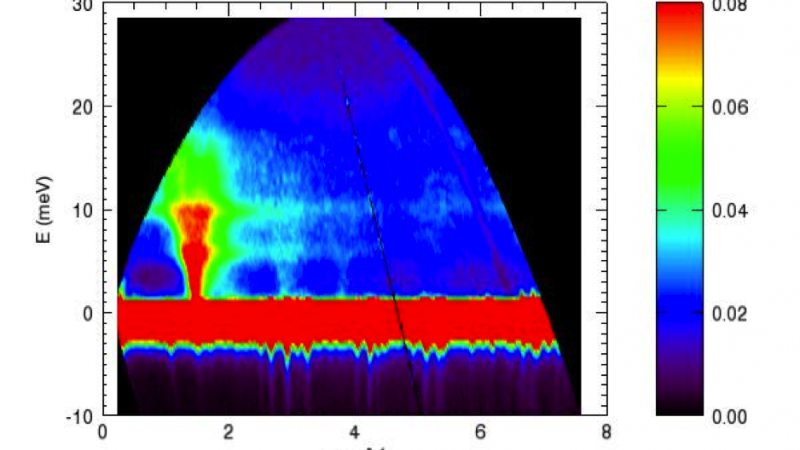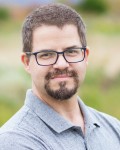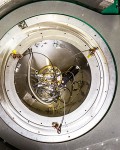Collin Broholm, a professor of physics at Johns Hopkins University in Baltimore, was clearly excited about the results he was reviewing in the control room of the Wide Angular-Range Chopper Spectrometer (ARCS) at SNS.
He is the principal investigator for three experiments to be run on ARCS on recently discovered materials. Broholm had arrived at the SNS at 10:30 a.m. for the start of one experiment, and by 3 p.m., colorful plots and images on the computer screens were yielding valuable new information.
“I am pleasantly surprised and impressed by the quality and quantity of data we have received in such a short time,” he said, referring also to his graduate student Jia Jia Wen and ARCS instrument scientist Matt Stone (who also once studied under Broholm). “We already have an image. The quantity of the data is excellent and so important for untangling the intricate effects of magnetism on the atomic scale.
“For us the outcome of this experiment is very exciting,” Broholm added. “The details are still emerging and we don’t know what it means yet, but it could be very interesting."
Broholm and his colleagues are conducting basic research on new antiferromagnetic materials discovered and synthesized at the Institute for Quantum Matter (IQM), a joint venture of Johns Hopkins and Princeton Universities, and at the Institute for Solid State Physics in Japan.
They are interested in the fundamental physics of novel materials, in particular correlated behavior among electron spins and the formation of correlated spin clusters. At ARCS that day, they used neutrons to measure changes in the collective behavior of electron spins, the spatial arrangement of the spins, and fluctuation frequencies of the spins (how often per time unit an electron spin direction flips) when the temperature of the sample is raised slowly from 5 to 200 Kelvin. (See "The Spin Doctor" for more details).
Although the research group is focused on fundamental physics, Broholm said that findings in this area of research could lead to practical applications in the next couple of decades. “By suppressing conventional magnetic order it might be possible to promote superconductivity at temperatures closer to room temperature,” Broholm said. “A longer-term application might be quantum computing.”
Unlike a personal computer, which makes one calculation at a time, a quantum computer can perform many calculations simultaneously through the magic of quantum coherence. Such a powerful computer, with massively parallel processing, would be useful for defense purposes, such as deciphering encrypted codes, but the most important applications cannot yet be predicted.
In other experiments at SNS on novel materials, Broholm’s group is using the Cold Neutron Chopper Spectrometer to probe low-energy fluctuations of electron spins and POWGEN (a powder diffractometer) to learn the details of their crystal and magnetic structures.
Since the 1990s Broholm has been involved in the evolution of the SNS project as a workshop participant, scientific advisor, and panel member. “For years I looked forward to this day when we can actually do experiments,” he said. “We are extremely excited by the possibilities we now see and are incorporating SNS into our scientific program.”
Broholm has discovered another benefit of the SNS. The experiments he is doing with graduate students, postdocs, and ORNL staff researchers give him a short reprieve from teaching Physics 101 to more than 300 undergraduate students. He wouldn’t say whether he has observed correlated behavior and clusters in his classes.
For more information, contact Collin Broholm at broholm@jhu.edu.
The Spin Doctor
An electron spin can be compared to the needle of a compass that points either north or south. Some electrons in a full shell point up, canceling out the electromagnetic fields of an equal number of electrons that point down.
The field of an electron spin that is not canceled in an unfilled shell makes some elements magnetic—iron, nickel, chromium, vanadium, and the rare earths. In the ARCS experiment at SNS, the novel material being probed with neutrons is a crystalline powder of a strontium-chromium-oxygen (SrCr2O4) compound, an antiferromagnetic material made at the Institute for Quantum Matter.
“We are studying materials with strongly correlated electrons, where each electron coordinates its motion with the immediate surroundings beyond a response to the average,” Collin Broholm, professor of physics at Johns Hopkins University, explained. “As a social analog, consider a crowd milling around in an airport. If each individual is not affected by the details of how people look and behave but just senses an anonymous crowd, we call this response mean field behavior, which is not so exciting.
“Instead, we are interested in electron spins that form dynamic clusters in response to interactions with other electrons. The social analog could be the spontaneous formation of groups of individuals chatting to each other after a frustrating flight delay is announced. To understand electron correlations we use neutrons, because their magnetic moment makes them exquisitely sensitive to electron spins.”
The SrCr2O4 crystalline structure consists of layers of chromium with oxygen atoms on its vertices; the Cr layers are separated by strontium atoms. In such compounds, the chromium atoms can be arranged in a square or triangular network. Owing to the so-called Pauli exclusion principle, the spins associated with each Cr atom seek anti-parallel alignment. In a square network, the spins can form a robust up/down (black/white) checkerboard pattern where no two up-spins are neighbors. In SrCr2O4, however, the chromium atoms form a triangular arrangement where up spins cannot be kept apart.
“Make yourself a triangular checkerboard and you will experience the frustration of electron spins as you try to color triangles black and white without neighboring white or neighboring black triangles,” Broholm explained. “You’ll find it’s impossible! We are interested in what replaces the checkerboard pattern when we force frustration upon the electron spins by placing them on a triangular lattice. The long-term goal is for superconductivity to arise in the wake of frustrated magnetism.
“The patterns of scattering obtained from the ARCS instrument provide unique information about spin correlations that we need to make progress,” Broholm said. “We infer the arrangement of electron spins based on how neutrons are scattered.”
As tiny magnets, neutrons are influenced by the time-dependent magnetic fields of fluctuating electron spins. The fields affect the energy and angle at which neutrons are scattered, and the scattering effects can be accurately cataloged in a large bank of neutron detectors.
Diagnosing the effects of electron spins on each other and taming them for our use take more than a few spin doctors—neutrons and giant detectors at the SNS are also required.
SNS is funded by the U.S. Department of Energy (DOE) Office of Basic Energy Sciences.






